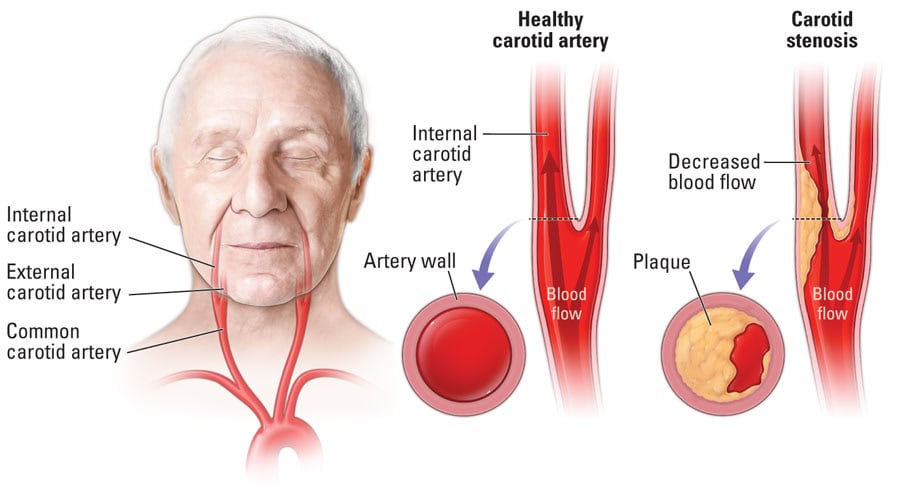
OVERVIEW
Carotid Artery Disease (CAD) occurs when the one or both of the two main neck arteries that supply the brain “harden” and get clogged with plaque deposits, made up of fat and cholesterol, along its walls (via a process known as atherosclerosis). CAD is a common cause of Ischemic strokes.
SYMPTOMS
Patients with CAD usually display no symptoms and are diagnosed only after a stroke or a transient ischemic stroke (“ministroke”). Common symptoms of a stroke include:
- Trouble speaking, understanding what others are saying. Patients might experience confusion or find themselves slurring their words.
- Paralysis or numbness usually occurs on one side of the body (in the face, arms or legs). Patients may also find it difficult to raise both their arms or find that one side of the face droops.
- Hand tremors
- Sudden dizziness, loss of balance, coordination
- Trouble seeing out of one or both eyes or sudden sensitivity to light
- Sudden, severe headaches
- Nausea and vomiting, difficulty swallowing
- Loss of consciousness
CAUSES/RISK FACTORS
- Age. Atherosclerosis may begin to develop during a person’s youth and slowly progresses into CAD and stroke as a person ages.
- Positive family history of stroke or atherosclerosis
- Previous history of stroke
- High blood pressure
- High cholesterol
- Obesity or physical inactivity
- Diabetes
- Smoking
DIAGNOSIS
There are a few scans/screenings for patients who fall into the high-risk group for a CAD. Several imaging tests may be implemented for diagnosis.
- Ultrasound
- Head CT scan
- MRI scan
- MRA (Magnetic Resonance Angiography)
- Cerebral Angiogram – also known as a Digital Subtraction Angiography (DSA), is a minimally invasive procedure where dye is inserted into the carotid artery through a catheter for an X-ray to be taken.
OUR TREATMENTS
In treating atherosclerosis, there are several lifestyle modifications that a patient can engage in to control their risk factors to prevent or delay CAD. If these lifestyle modifications are insufficient, our specialists may recommend medications or minimally invasive surgery.
- Angioplasty and Stenting
Angioplasty and stenting are minimally invasive techniques that are an equally effective treatment in which doctors widen the arteries to restore blood flow to the head. A catheter is inserted into the artery, and a balloon is inserted through it and inflated to widen arteries. A stent is then placed into the artery to support the walls of the artery and prevent it from narrowing again.
- Open surgery (Endarterectomy)
The traditional treatment of CAD is an endarterectomy where doctors make an incision in the neck to access the artery to remove the plaque or blockage, in the lining of the artery to restore flow.
References:

